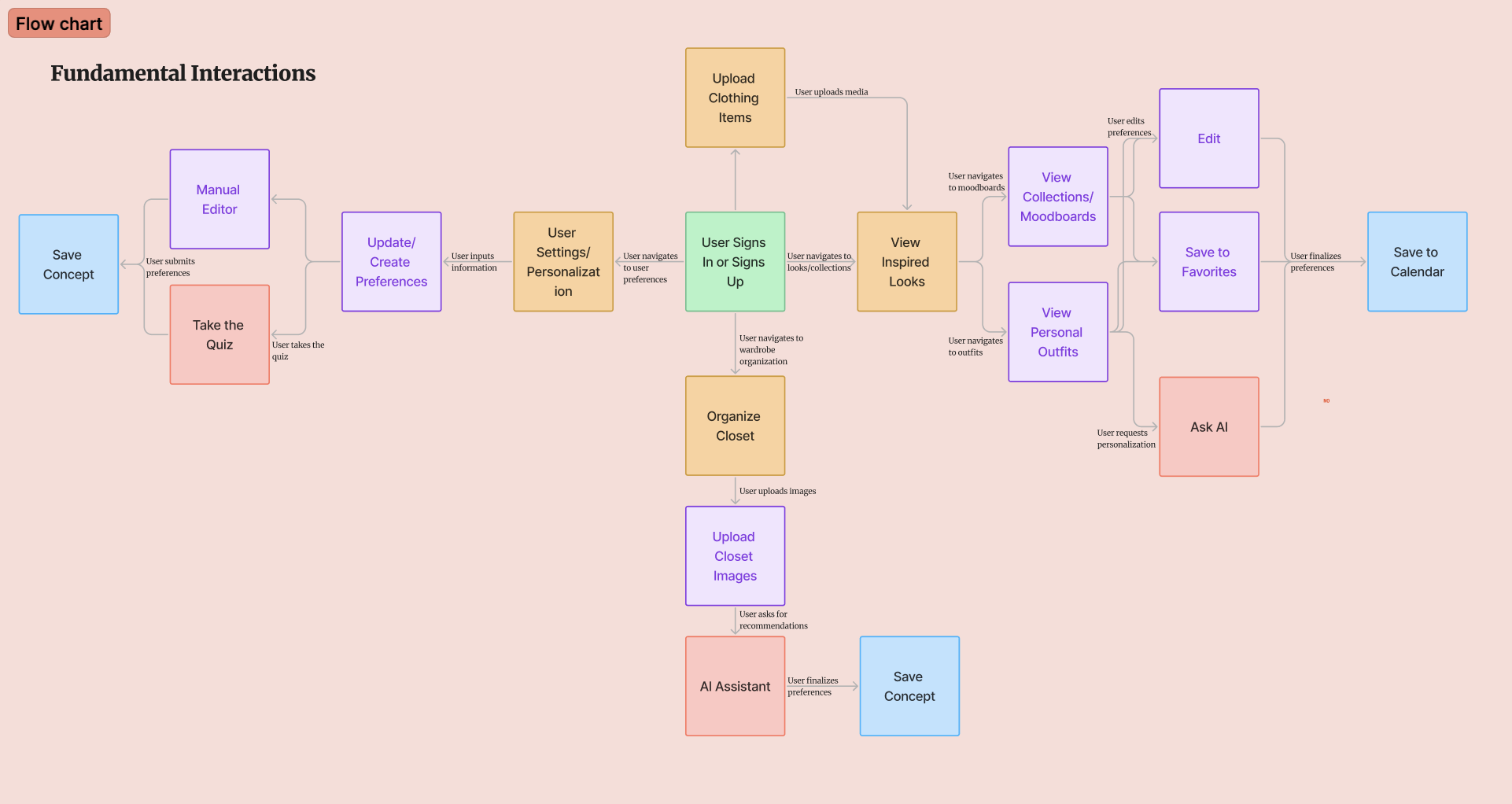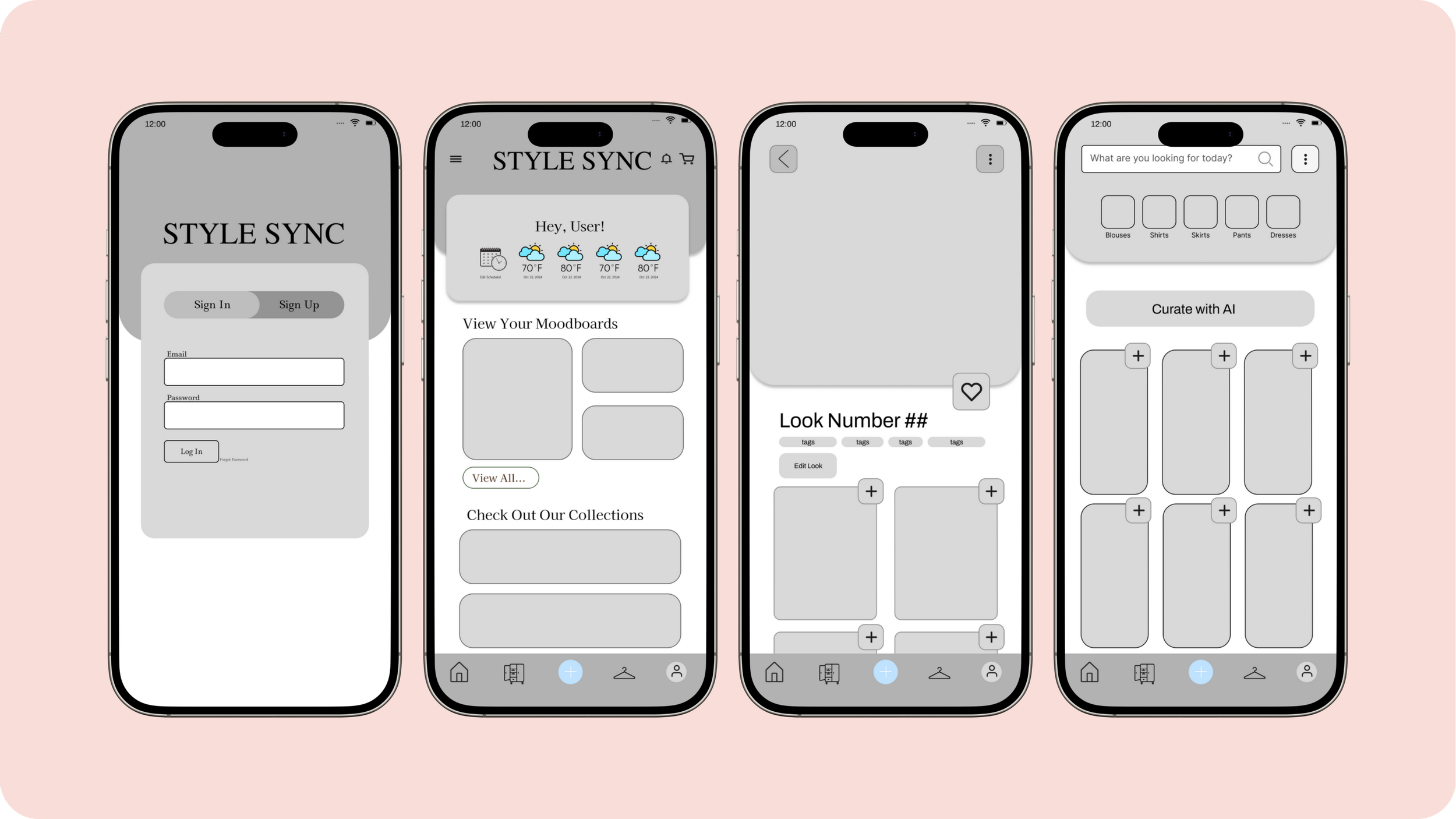Style Sync
An AI-powered wardrobe management and personalized styling app
About the App
Style Sync – formerly known as LookBook – is your personal wardrobe management assistant. Beyond simply organizing clothing, it empowers users to maximize their wardrobe’s potential, reduce decision fatigue, and embrace more sustainable fashion habits. This comprehensive tool simplifies closet organization and outfit planning by allowing users to upload photos of their wardrobe items. Rather than physically digging through the closet, users can scroll through their online wardrobe. The app then provides personalized organization strategies and curated outfit recommendations tailored to individual style preferences, weather conditions, and upcoming events. With its intuitive interface and smart suggestions, Style Sync transforms daily dressing routines into a more efficient, enjoyable, and fashion-forward experience.
-
September 2024 - December 2024
-
Rutgers MBS - Academic Project
-
Mobile
-
Our team was compromised of UX and Product Designers. I was joined by a wonderful team with Ashley F, Bhanu T, Mike M, and Udayan R.
-
Disorganization: Users often lose track of what they own, leading to clutter, decision fatigue, and unnecessary purchases which can add stress to their already busy daily lives.
Decision Fatigue: Users feel overwhelmed choosing outfits, especially for busy schedules or specific events, and need tools to simplify and align choices with their style.
Sustainability Awareness: Despite growing interest in eco-friendly fashion, users often lack tools to track clothing usage, reduce waste, and make sustainable choices.
Opportunity Screening
Individuals of our team brainstormed to create a product, conduct user research, and formulate design, development, and business strategies to position our product for success in a competitive market.
Developing Opportunities
We considered a variety of questions including the following:
Is there an existing market?
Is the product possible?
Can the product be competitive?
Will the product be profitable at an acceptable risk?
Does launching this product make sense?
By assessing these questions, we were able to confirm our project was within our skills and would be a competitive product.
Competitor Analysis
Conducting a comprehensive competitor analysis is essential to identify strengths, weaknesses, opportunities, and threats in the market landscape. Our analysis focused on four primary competitors and we were able to assess that our product addresses competitor gaps with AI-driven categorization and personalized outfit suggestions, targeting both tech-savvy users and those frustrated with manual entry.
Market Segmentation
By categorizing the market based on demographics, behavior, and preferences, we can effectively allocate resources, maximize customer satisfaction, and achieve higher conversion rates. Our market segmentation model assessed key categories: Competitors, AI Technology, User Experience, Pricing, Strengths, and Weaknesses. This structured analysis enabled us to strategically position Style Sync within the competitive landscape, identifying gaps and opportunities to differentiate.
User Research
User research is a critical component in product development as it provides valuable insights into the needs, preferences, and pain points of the target audience. By engaging with potential users through interviews and surveys our team can validate assumptions, uncover hidden challenges, and make sure that the product design aligns with real-world demands. This data-driven approach minimizes risks, informs strategic decisions, and ultimately enhances user satisfaction by delivering a solution that effectively addresses user needs and stands out in the competitive market.
Product Planning
We plan for the architecture to include layers for user interaction, core services, AI processing, data management, and integrations. Key features include customizable dashboards, voice commands, image recognition, and AI-driven outfit suggestions.
Step 1
Opportunity Identification
Step 2
Product Setup
1. System Architecture Overview:
User Interface Layer: Customizable dashboard, voice command interface, and consistent mobile/web design ensure a seamless user experience across devices.
Core Services Layer: Manages user authentication, personalization, image recognition, and AI-driven outfit management.
AI & ML Layer: Advanced computer vision and style learning models provide personalized outfit suggestions based on user preferences, weather, and events.
Data Management Layer: Centralized databases store user profiles, wardrobe items, style preferences, and usage analytics securely.
External Integrations: Real-time weather data, retail API connections for shopping suggestions, and secure cloud storage for images and backups.
2. Functional Clustering:
UI Hub: Wardrobe cataloging, outfit suggestion dashboard, and profile management.
Core Application Services: Image recognition, personalized outfit generation, and event-based recommendations.
AI & Data Integration: Weather and retail data integration, analytics, and user behavior tracking.
Backend Planning: Secure authentication, data storage, and load balancing for optimal performance.
Security & Compliance: Data encryption, privacy protocols, and secure cloud storage to ensure user data protection.
3. Environmental Considerations:
Identified environmental impacts include carbon emissions from data processing, electronic waste from device upgrades, and pollutants from data centers.
Strategies include optimizing code for efficiency, partnering with renewable-energy-powered data centers, and promoting device recycling.
Creating a fundamental interaction chart is important for product planning as it visually maps out the user's journey, identifying key interactions, decision points, and potential pain points. This helped our team gain clarity and understand our foundational organization to set a structure.
Creating low fidelity wireframes helped our team decide on a design and navigational layout to start the team’s design process.
Step 3
Implementation & Iterations
The Style Sync app prototype, designed entirely using Figma, includes core features such as onboarding, wardrobe organization, outfit planning, and AI-powered suggestions. Upon user testing, feedback revealed areas for improvement in navigational icons, accessibility, and feature integration, including clearer access to outfit creation, combining AI and weather suggestions, and enhancing calendar functions. Accessibility adjustments, such as larger buttons and streamlined processes, were recommended, along with integrating sustainability markers into individual items rather than a separate page.
A/B Testing: After prototyping and user testing, an iterative process began —> leading to A/B testing of many screens.
The most important screen to A/B test was our home screen.
Step 4
Next Steps
Our next steps following the prototyping and user feedback phase include evaluating the financial feasibility and profitability of Style Sync by estimating development costs, potential revenue streams, and taxation implications. Key focus areas involve:
Development Costs: Estimating expenses for software development, AI/ML integration, UI/UX design, and testing, with projected costs ranging from $95,000 to $300,000 over three years.
Revenue Analysis: Implementing freemium, subscription, and ad-supported models to generate estimated annual revenue of $240,000–$600,000.
Profitability Analysis: Determining profit per user, gross profit margins, and the break-even point, targeting a cost per user of approximately $4.32 and a revenue per user of $15 annually.
Tax Considerations: Accounting for state-specific sales tax, federal income tax, and app store commissions, while exploring optimal pricing strategies to maintain profitability.
IP Protection: Initiating trademark, patent, and copyright applications to safeguard Style Sync’s AI-powered functionalities, branding, and user interface design.
Future Recommendations:
AR (Augmented Reality) fitting: This feature enables users to seamlessly visualize outfit combinations in real time, offering a dynamic and interactive way to explore different styling options. By seeing how various pieces work together, users can make more confident fashion decisions, experiment with new looks, and feel empowered to express their personal style effectively.
Partnerships: We hope to partner with retail stores, providing suggested garments to complete a personalized and unique look to the user.
Takeaways:
Teamwork: In a design setting, it is important to stay focused on the solution rather than being very attached to your design. While we may have personal preferences on design, it is important to balance client needs, solutions, and overall teamwork.
Iterative Process: UXD & Product Design are iterative processes. Applying agile methodologies in UX design and product development emphasizes iterative processes, user-centric approaches, and adaptive planning.









